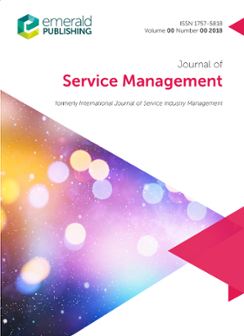Some agents are more similar than others: customer orientation of frontline robots and employees
IF 7.8
2区 管理学
Q1 MANAGEMENT
引用次数: 1
Abstract
PurposeThe impact of frontline robots (FLRs) on customer orientation perceptions remains unclear. This is remarkable because customers may associate FLRs with standardization and cost-cutting, such that they may not fit firms that aim to be customer oriented.Design/methodology/approachIn four experiments, data are collected from customers interacting with frontline employees (FLEs) and FLRs in different settings.FindingsFLEs are perceived as more customer-oriented than FLRs due to higher competence and warmth evaluations. A relational interaction style attenuates the difference in perceived competence between FLRs and FLEs. These agents are also perceived as more similar in competence and warmth when FLRs participate in the customer journey's information and negotiation stages. Switching from FLE to FLR in the journey harms FLR evaluations.Practical implicationsThe authors recommend firms to place FLRs only in the negotiation stage or in both the information and negotiation stages of the customer journey. Still then customers should not transition from employees to robots (vice versa does no harm). Firms should ensure that FLRs utilize a relational style when interacting with customers for optimal effects.Originality/valueThe authors bridge the FLR and sales/marketing literature by drawing on social cognition theory. The authors also identify the product categories for which customers are willing to negotiate with an FLR. Broadly speaking, this study’s findings underline that customers perceive robots as having agency (i.e. the mental capacity for acting with intentionality) and, just as humans, can be customer-oriented.一些代理比其他代理更相似:一线机器人和员工的客户导向
目的:一线机器人(flr)对客户导向感知的影响尚不清楚。这是值得注意的,因为客户可能将flr与标准化和成本削减联系在一起,因此它们可能不适合以客户为导向的公司。设计/方法/方法在四个实验中,收集了客户在不同环境下与一线员工(fle)和一线员工(flr)互动的数据。研究发现,由于更高的能力和热情评价,员工被认为比flr更以客户为导向。关系互动方式减弱了外劳与外劳之间的感知能力差异。当flr参与客户旅程的信息和谈判阶段时,这些座席在能力和热情方面也更加相似。在旅程中从FLE切换到FLR会损害FLR评估。实际意义作者建议公司只在谈判阶段或在客户旅程的信息和谈判阶段放置flr。然而,客户不应该从员工转向机器人(反之亦然)。公司应确保flr在与客户互动时利用关系风格以获得最佳效果。原创性/价值作者通过借鉴社会认知理论,将FLR和销售/营销文献联系起来。作者还确定了客户愿意与FLR谈判的产品类别。从广义上讲,这项研究的发现强调了客户认为机器人具有能动性(即具有意向性行动的心智能力),并且和人类一样,可以以客户为导向。
本文章由计算机程序翻译,如有差异,请以英文原文为准。
求助全文
约1分钟内获得全文
求助全文
来源期刊

Journal of Service Management
MANAGEMENT-
CiteScore
19.20
自引率
9.40%
发文量
55
期刊介绍:
The Journal of Service Management (JOSM) centers its scope on research in service management. It disseminates papers showcasing distinctive and noteworthy contributions to service literature, serving as a communication platform for individuals in the service management field, transcending disciplines, functional areas, sectors, and nationalities. The journal publishes double-blind reviewed papers emphasizing service literature/theory and its practical applications.
 求助内容:
求助内容: 应助结果提醒方式:
应助结果提醒方式:


